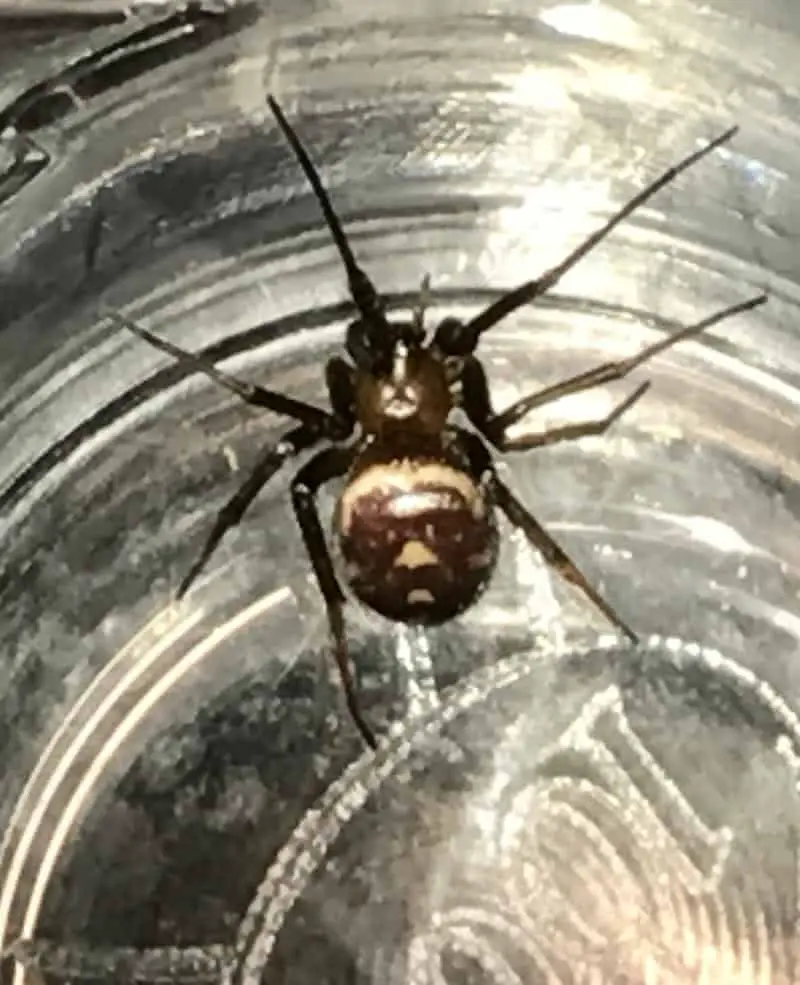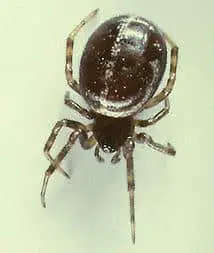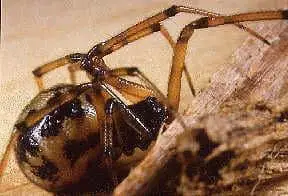Steatoda belong to the spider family Theridiidae, or the cobweb weavers. Also known as Combfooted Spiders, this family includes a number of well known arachnids, including one type of common house spider, Achaearanea tepidariorum, and the widow spiders Latrodectus spp. Steatoda spiders are found throughout the world, in both temperate and tropical climates. At least eight Steatoda spp. can be found within the U.S. Steatoda spiders are small to moderately small (3-9 mm) spiders with oval abdomens; they may be reddish, brownish or black, with most species exhibiting a white band at the front of the dorsal abdomen which may resemble a collar. Steatoda spiders construct a strong, irregular web, somewhat resembling the webs of widow spiders; this web is very sticky, making it a highly effective snare for hobo spiders.
Table of Contents
Steatoda grossa, the false black widow spider
The false black widoe is the most well known of the Steatoda spiders. Found in cosmopolitan areas around the world, and on both coasts of the United States, grossa is a larger (9 mm) Steatoda which, as its common name suggests, may resemble a black widow spider (with no hourglass).

Specimens can be reddish to purplish brown in color, with pale yellow markings on the dorsal abdomen, but many specimens are so dark that these pale markings cannot be distinguished. Steatoda grossa is a common and well known “house spider” in many areas, constructing its webs in and around buildings, rock walls, and other structures. It has long been known that the “false black widow” will ensnare, kill and prey upon actual black widow spiders in its natural habitat. Steatoda grossa has been observed to ensnare and prey upon hobo spiders.
Steatoda hespera
The western Steatoda or western bud spider, is a smallish (7-8 mm), brown cobweb weaver that is often misidentified as a small “brown” black widow: Pictured above right, this species is common throughout the eastern half of the U.S. range of the hobo spider. It now appears that this little arachnid may be the single most effective predator of the hobo spider.

Steatoda triangulosa
The triangulate cobweb spider or the triangulate Steatoda, or triangulate bud spider, is a cosmopolitan species found in various areas of the world. This spider is moderately small (5 mm), reddish to reddish-brown in color, and exhibits a well defined pattern of light colored triangles on the dorsal abdomen.
This small household spider is easily overlooked as it weaves cobwebs in the dark corners of houses, basements, and outbuildings. The body is only about 1/8 to ¼ inch long. The cephalothorax is brownish orange. Each segment of the yellow legs is darker. This species is probably native to Eurasia and has been introduced to North America relatively recently. It is known from central and southern Europe, southern Russia, the Mediterranean, St. Helena, and the United States.

It is rare in South America. In North America it is widespread and abundant locally in and on houses. In both Europe and North America it lives in houses in the northern part of its range and under stones and on walls of buildings in the southern part of the range. It is common in towns and cities, in and around man-made structures, in dark corners of walls, lower angles of windows, and under eaves.
Like other comb-footed spiders (family Theridiidae), these spiders build irregular webs and suspend themselves from these snares while waiting for unsuspecting prey to approach. Using a comb of serrated bristles on their hind legs they enswathe their prey in sticky silk and wait for it to quiet before approaching close enough to bite.
Steatoda triangulosa is a frequent associate of the brown recluse and the common house spider in closets and crannies (Fitch 1963). It has been known to prey on many kinds of arthropods, including ants, spiders (including the brown recluse), ticks, and pillbugs. In Texas it has been known to prey on fire ants and spiders inhabiting utility equipment housings.
Mating spiders and egg sacs have been found from late spring through early fall. Egg sacs, about the size of the adult spider, are made of loosely woven white silk, and about 30 eggs are visible inside each sac.
Severe envenomation is uncommon following the bite of Steatoda species, and there are no known cases of human envenomation by S. triangulosa. When Steatoda poisoning does occur, the neurotoxic symptoms are similar to those resulting from black widow bites. The related species Steatoda grossa, known as the false black widow or cupboard spider, has been blamed for severe local and regional pain, nausea, and vomiting in Australia. The symptoms, similar to those seen in latrodectism, have been treated successfully with Latrodectus antivenom . In the United States, S. grossa is confined to the Gulf Coast and the West Coast. Fortunately, it appears that this species does not occur in Arkansas. At least two species of Steatoda have also been implicated in human envenomations in Europe.
Another related species, S. borealis, is considered one of the comb-footed spiders of most concern to urban pest controllers, along with the black widow and common house spider. It is easily distinguished from S. triangulosa by the dark colored abdomen with a narrow, light colored median line. Although it is the most common Steatoda of the eastern United States, it has never been found in Arkansas and it is apparently rare south of Illinois, Iowa, and Nebraska.
Click here for more photos of Steatoda Spiders.
Information and pictures were taken from children’s projects and where credited to that child does not claim to be original information. Where possible, permission to reproduce has been sought. Any infringement of copyright is purely unintentional.

